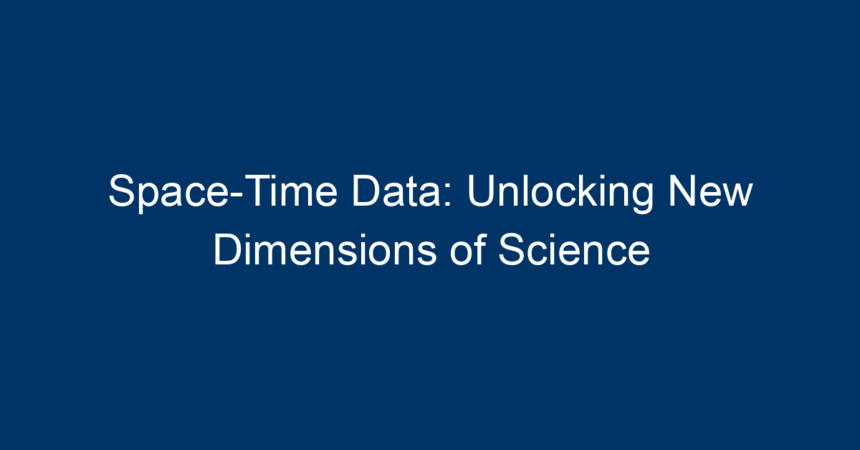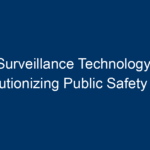In our quest to understand the universe, the concept of space-time data has emerged as a groundbreaking frontier, merging the realms of physics, data science, and technology. This innovative approach opens up new avenues for exploration and discovery, allowing scientists and researchers to analyze complex phenomena like never before. Join us as we delve into the fascinating world of space-time data and uncover its potential to transform various scientific fields.
What is Space-Time Data?
At its core, space-time data refers to information that combines spatial and temporal elements. This includes not just where something occurs, but also when it happens. By integrating these two dimensions, researchers can enhance their understanding of dynamic systems, from climate change to urban planning, and even astrophysics.
The Foundations of Space-Time Analysis
The idea of space-time is rooted in Einstein’s theory of relativity, which revolutionized our understanding of the cosmos. Traditional data analysis often separates time and space, treating them as distinct entities. In contrast, space-time data views them as interconnected, enabling a more comprehensive examination of complex interactions.
The Importance of Space-Time Data in Science
1. Advancements in Astrophysics
Astrophysics is one of the fields where space-time data has made marked advancements. By analyzing light from distant celestial objects, researchers can track movement and evolution over time. This capability has led to significant breakthroughs, such as:
- Understanding the expansion of the universe.
- Tracking gravitational waves.
- Analyzing cosmic events like supernovae.
All these accomplishments rely heavily on parsing spatial and temporal information to derive meaningful insights.
2. Climate Science and Environmental Monitoring
Climate scientists utilize space-time data to model and predict weather patterns and environmental changes. By integrating satellite imagery with temporal data, researchers can:
- Monitor deforestation rates.
- Analyze the impact of urbanization on local climates.
- Predict natural disasters with greater accuracy.
These insights are invaluable for developing policies aimed at mitigating climate change and protecting vulnerable ecosystems.
3. Urban Planning and Smart Cities
As cities expand, the need for effective urban planning has never been more critical. Space-time data can aid urban planners by allowing them to track population movement and resource allocation over time. This can include:
- Optimizing public transportation routes based on shifting demand.
- Predicting traffic patterns during special events.
- Planning for sustainable growth in line with population trends.
Implementing these strategies ensures cities are more efficient, sustainable, and livable.
4. Health and Disease Tracking
In the field of public health, space-time data plays a pivotal role in tracking disease outbreaks and understanding health trends. By mapping the incidence of illness over time and across specific locations, researchers can:
- Identify high-risk areas.
- Develop targeted intervention strategies.
- Allocate resources effectively during health crises.
The COVID-19 pandemic showcased the urgency of such data analysis, highlighting the importance of a well-coordinated response based on spatial-temporal information.
Tools and Technologies for Space-Time Data Analysis
Geographic Information Systems (GIS)
One of the most effective tools for analyzing space-time data is Geographic Information Systems (GIS). This technology allows users to:
- Create layered maps that incorporate various datasets.
- Visualize changes over time, making it easier to spot trends and anomalies.
As the volume of data grows, GIS continues to evolve, enabling more sophisticated analyses and enhancing decision-making processes across different domains.
Data Mining and Machine Learning
Data mining techniques and machine learning algorithms are invaluable for processing space-time data. These technologies can detect patterns that may not be immediately apparent, offering insights that inform scientific research, business strategy, and policy development. For instance:
- Predictive analytics can forecast future events based on historical trends.
- Machine learning models can optimize workflows in various industries by analyzing complex datasets.
Real-Time Data Acquisition Tools
The advent of IoT (Internet of Things) devices has significantly contributed to the availability of real-time space-time data. Sensors and mobile devices continuously gather data, allowing for immediate analysis and timely decision-making. This capability is essential for:
- Emergency response during natural disasters.
- Real-time traffic management systems.
- Dynamic resource allocation in healthcare settings.
Challenges in Space-Time Data Analysis
Data Quality and Integration
One of the primary challenges in utilizing space-time data is ensuring data quality and consistency. Disparate data sources can lead to inaccuracies and complications in analysis. Researchers must adopt rigorous data stewardship practices, employing standardization techniques to ensure that data from various sources can be integrated seamlessly.
Privacy Concerns
As with any technology that relies on personal data, privacy issues must be addressed. The collection of space-time data—especially from personal devices—raises significant ethical considerations. Implementing robust data anonymization and protection strategies is essential to safeguard individual privacy while reaping the benefits of this powerful analytical tool.
Complexity and Interpretability
Analyzing space-time data often involves complex algorithms and multifaceted models. Ensuring that insights derived from such analysis are easily interpretable by stakeholders—ranging from scientists to policymakers—is crucial for effective communication and action.
The Future of Space-Time Data in Science
Interdisciplinary Collaboration
The future of space-time data lies in interdisciplinary collaboration. As various fields continue to adopt this approach, the potential for innovative solutions increases. Collaborative projects that bridge the gap between scientists, data analysts, and policymakers can lead to transformative insights that address pressing global challenges.
Enhanced Computational Power
As computational power enhances and data storage becomes more affordable, scientists will be able to analyze larger datasets with greater precision. This advancement will lead to more nuanced understandings of both historical trends and predictive models, driving breakthroughs across numerous disciplines.
Expansion into Everyday Life
The effects of space-time data will increasingly permeate everyday life. Applications in smart homes, autonomous vehicles, and personal health tracking will offer consumers unprecedented insights into their environments, enhancing quality of life through data-driven decision-making.
Conclusion: Actionable Insights for Embracing Space-Time Data
The realm of space-time data is not merely an abstract concept; it is a powerful tool that holds the potential to revolutionize scientific inquiry and practical applications. As we explore its benefits, it is essential to:
- Invest in Training: Equip yourself and your team with the skills necessary to analyze and interpret space-time data effectively.
- Adopt Advanced Tools: Utilize GIS, machine learning, and real-time data acquisition tools to augment your research or business strategy.
- Prioritize Ethics: Address privacy and ethical concerns by adopting best practices for data collection and analysis.
- Encourage Collaboration: Foster partnerships across disciplines to leverage diverse insights and enhance the impact of space-time data.
By embracing these actionable insights, we can unlock the full potential of space-time data, paving the way for innovation that transcends traditional boundaries and drives us toward a better understanding of our world.




